Jumping into the world of electric scooters can feel a bit overwhelming with all the specs and models out there. The secret? Figure out what you need before you even start looking at what's for sale.
It's tempting to dive right into comparing motor power and battery life, but the best scooter for you is the one that actually fits your life. A little self-reflection now saves a lot of headaches (and buyer's remorse) later.
Defining Your Perfect Ride Before You Shop
So, let's start with the basics. Forget the tech specs for a minute and just think about how you're going to use this thing. Is it for your daily slog to the office? A fun way to zip around town on a Saturday? Or just for those quick trips to the corner store? Your answer changes everything.
Your Daily Commute and Terrain
First up, your route. How far are you going each day, round trip? A quick 3-mile jaunt is one thing; a 15-mile commute is a completely different beast and demands a much bigger battery.
Now, picture the journey itself. Are you cruising along flat, smooth bike lanes, or are you tackling the kind of hills that make you sweat just looking at them? A scooter that's a dream on flat ground can quickly become a sluggish nightmare on a steep incline, not to mention it will chew through your battery life.
The same goes for the surfaces you'll be riding on. Perfectly smooth pavement is easy, but what about cracked sidewalks, or even the occasional dirt path? For rougher terrain, you'll be thankful for good suspension and beefy tires. Trust me, your joints will thank you.
Portability and Lifestyle Fit
Think about the "in-between" moments of your journey. Will you need to carry your scooter onto a train or haul it up three flights of stairs to your apartment? If so, weight suddenly becomes a massive deal. A hefty 45 lb scooter feels like a deadlift after a long day. Many of the best commuter scooters are built to be light and fold up in seconds for exactly this reason.
This handy visual breaks it down nicely: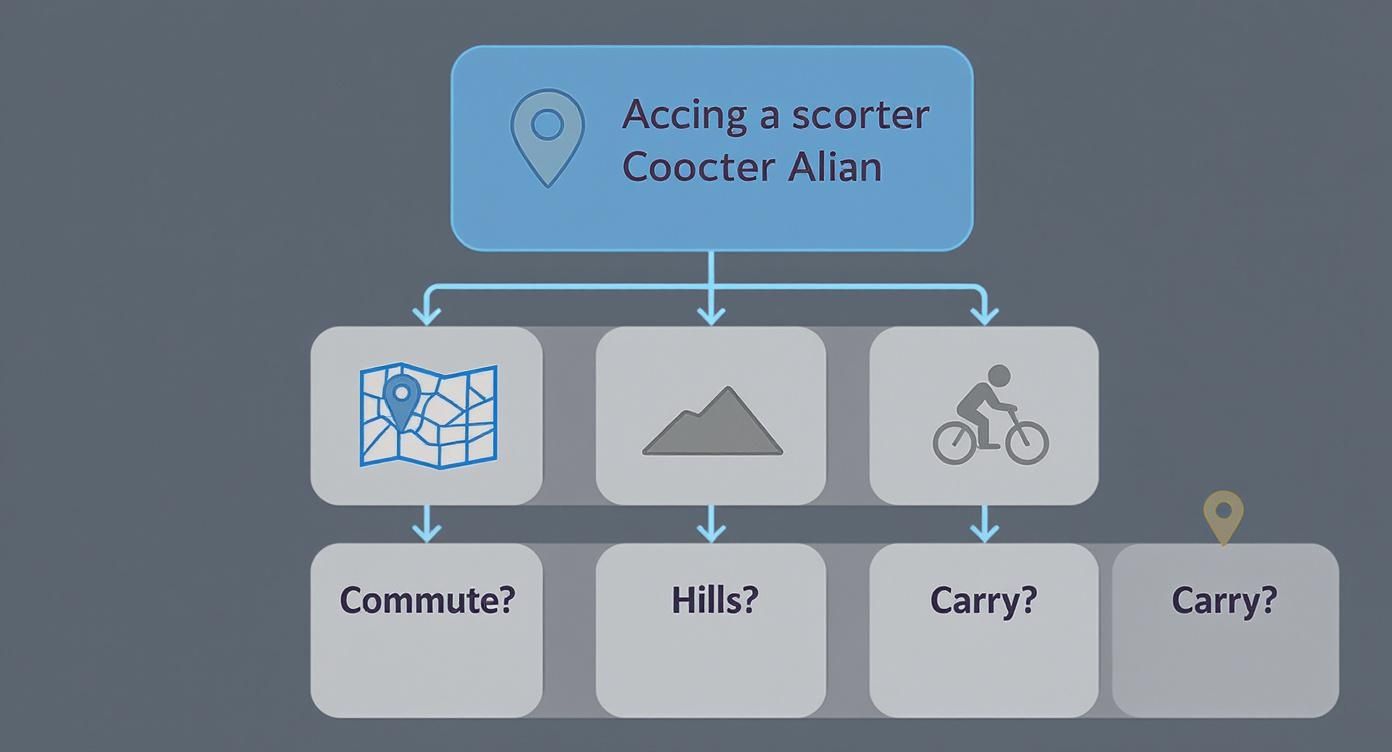
As you can see, a long, hilly commute points you towards a more powerful, long-range model. But if you’re mixing your ride with public transport, a lightweight, compact design is your best friend.
Before you start browsing, it's a great idea to quickly jot down your personal requirements. This simple checklist will be your North Star when you're comparing different models.
Your Personal Scooter Requirements Checklist
| Factor | Your Requirement (e.g., 'Under 35 lbs', 'At least 15-mile range') | Priority (High/Medium/Low) |
|---|---|---|
| Range | ||
| Top Speed | ||
| Weight | ||
| Hill Climb Ability | ||
| Suspension | ||
| Budget | ||
| Foldability |
Once you've filled this out, you'll have a crystal-clear picture of what you're looking for, which makes the whole process so much easier.
By separating your "must-haves" from your "nice-to-haves" now, you create a clear checklist. This makes the next step—comparing different models and features—much more straightforward.
This planning is more important than ever. The electric scooter market is exploding—it's expected to hit USD 91.1 billion by 2035 as more people look for smarter ways to get around cities. That means more choices for you, but it also means more noise to cut through.
With your personal criteria in hand, it's way easier to compare electric scooter models and find the one that’s truly right for you.
Getting Real About Range, Speed, and Power
Alright, you’ve got a picture in your head of the perfect scooter. Now for the nitty-gritty: the engine room specs. This is where the marketing hype meets the road, and understanding range, speed, and power is key to not being let down after your first ride.
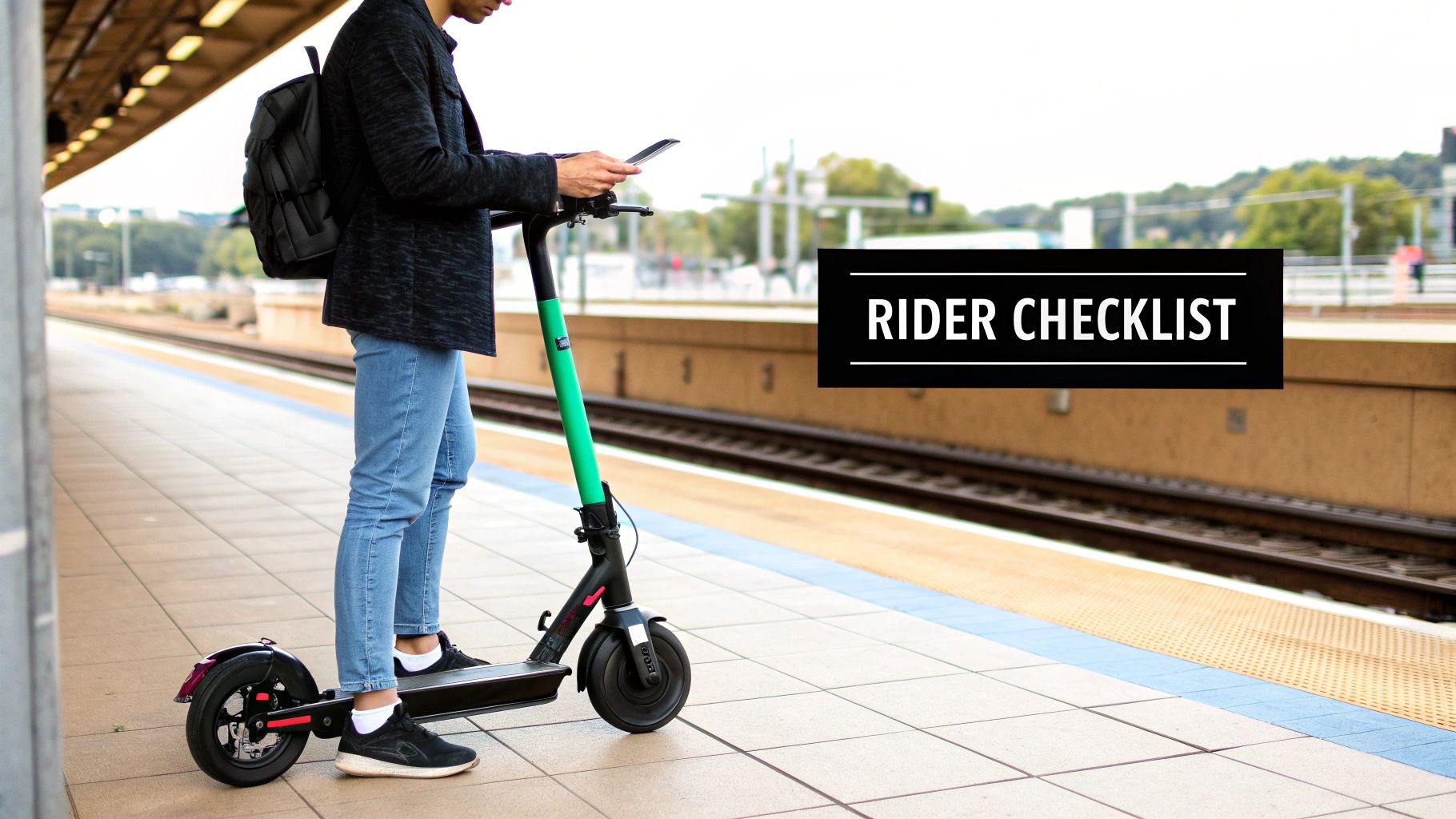
What "Range" Actually Means on the Street
"Range anxiety" is a real thing, even for us scooter riders. You’ll see a big, juicy number on the box—"Up to 25 miles!"—but you have to take that with a massive grain of salt. Think of it as the absolute best-case scenario, achieved by a lightweight rider on a perfect day in a lab.
Your actual mileage will almost always be less. Why the big difference? It boils down to a few key things:
- Your Weight: The scooter's motor has to work harder to haul a heavier rider, which eats into the battery.
- The Terrain: Cruising on flat ground is one thing. Tackling hills is a whole different beast and will drain your battery fast.
- Your Riding Style: If you're constantly mashing the throttle and riding at top speed, you'll burn through your charge way quicker than if you're cruising at a steady, gentle pace.
- The Weather: Batteries hate the cold. Expect your range to take a noticeable hit during those chilly winters.
If you want to get really deep into the weeds on this, it's worth understanding all the little things that can affect your electric scooter's real-world range.
My Pro Tip: As a general rule of thumb, take whatever range the manufacturer claims and knock off about 30%. That’ll give you a much more realistic number for your everyday rides.
Power and Speed: What You Actually Need
Motor power is measured in watts (W), and it's what gives your scooter its oomph—its acceleration and hill-climbing muscle.
If you're just zipping around a mostly flat city, a motor in the 250W to 350W range is plenty. But if your commute involves any serious hills, you’ll be much happier with 500W or more. Anything less and you'll find yourself slowing to a crawl on inclines.
The battery is the other side of the coin. Its capacity is measured in Amp-hours (Ah) or, more usefully, Watt-hours (Wh). Think of Wh as the size of your fuel tank. More Wh means more range. A solid commuter scooter usually sits around 360Wh, while the real long-haul models can push past 600Wh.
The Tech Inside: Motors and Batteries
The heart of your scooter is its motor and battery. Thankfully, the tech here has gotten really good. Most e-scooters now use lithium-ion batteries, which are lighter and more efficient than older types, meaning they last longer and need less looking after.
You'll also find that most dependable scooters use a hub motor built right into the wheel. It’s a brilliant design—it's quiet, super-efficient, and practically maintenance-free. It has become the gold standard for a reason.
Don't Forget Build Quality, Safety, and Comfort
It’s easy to get caught up in the flashy numbers—top speed, max range—but honestly, those specs mean nothing if your scooter feels like it’s about to rattle apart on a bumpy road. The real mark of a great scooter is how it’s built, how safe it feels, and how comfortable it is to ride. These are the things that give you the confidence to actually enjoy zipping around town.
When you're looking for a scooter that feels solid under your feet, the braking system is the absolute first thing you should check. Having a scooter that stops when you need it to is non-negotiable.
The Holy Trinity: Brakes, Suspension, and Tyres
You’ll generally see three types of brakes: mechanical disc, hydraulic disc, and regenerative. Mechanical disc brakes are the reliable workhorses of the scooter world. They give you solid stopping power and are pretty straightforward to maintain. Hydraulic brakes are a step up—they cost a bit more but deliver serious stopping force with just a light squeeze of the lever.
Regenerative brakes are a cool piece of tech that recaptures a bit of energy when you slow down, feeding it back into the battery. It's great for stretching your range and needs zero maintenance, but it won’t provide the hard, emergency stopping power you need. That's why you’ll almost always find it paired with a primary mechanical or hydraulic brake.
Next, let's talk suspension. If your commute involves anything other than perfectly smooth pavement—and let's be real, most do—suspension is a total game-changer. Think cracked pavement or rough bike lanes. Good suspension soaks up all those jolts, giving you a far smoother and more controlled ride.
Finally, the great tyre debate. You've got two main choices:
- Pneumatic (Air-Filled) Tyres: These are the kings of comfort. The air inside acts like a natural cushion, smoothing out every bump. The only catch? They can get punctures.
- Solid Tyres: Made of solid rubber or foam, these are completely puncture-proof, which is a huge plus. The downside is you'll feel every single crack in the pavement. It can be a pretty jarring ride.
For most of us riding in the US and Australia, pneumatic tyres are the way to go. The comfort they provide is just too good to pass up, and you can always add some anti-puncture sealant to drastically reduce the risk of getting a flat.
Why the Frame and Fit Matter
The physical structure of the scooter is just as important as the moving parts. The frame material is a big deal, affecting both how much the scooter weighs and how tough it is. Most decent scooters use an aluminium alloy, which hits that sweet spot of being strong enough for daily abuse while staying light enough to carry up a flight of stairs.
Comfort is also about how the scooter fits you. A nice, wide deck gives you space to shift your feet around on longer journeys, which makes a huge difference in fighting off fatigue. Pay attention to the handlebar height, too. If you’re on the taller side, a scooter with low-set handlebars will have you hunched over, which is not only uncomfortable but also pretty unsafe.
A well-built scooter isn't just about surviving bumps; it's about giving you a stable, predictable, and genuinely enjoyable ride every single time. Never let flashy speed stats distract you from these fundamental safety and comfort features.
Getting a feel for all these components is a massive part of a safe riding experience. In fact, it's a cornerstone of our essential electric scooter safety tips for anyone new to the scene.
Getting to Grips with US and Australian Scooter Laws
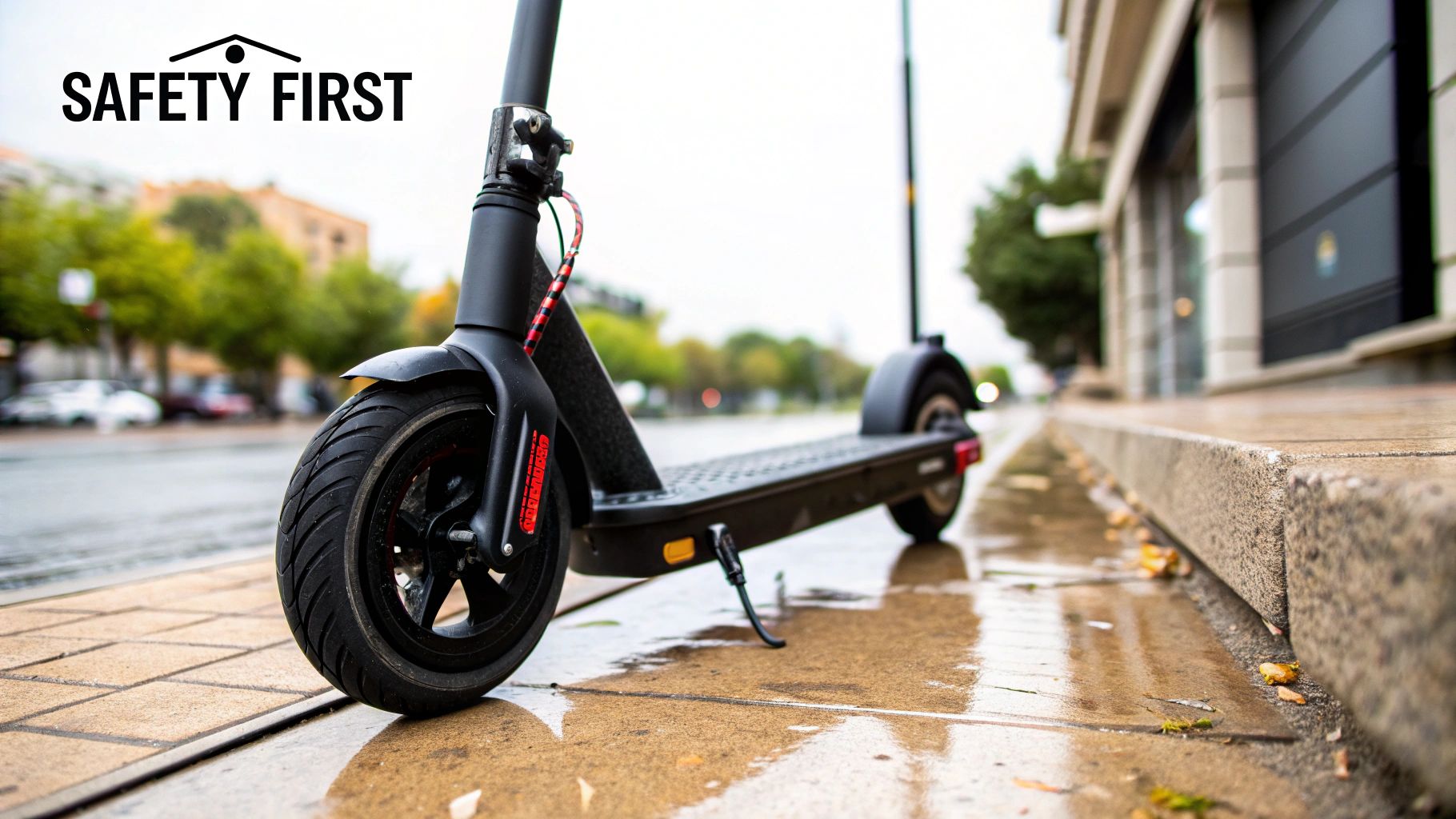
It’s an easy mistake to make, but a costly one: you find the perfect scooter, click "buy," and then discover it’s not actually legal to ride where you live. Honestly, the rules for e-scooters across the US and Australia are a complex patchwork. What’s totally fine in one state could land you a nasty fine in another. So, before you get your heart set on a specific model, it’s crucial to get your head around the local laws.
In the US, there's no single federal law. Regulations are decided at the state and even city level, leading to huge variations. For example, California is famously scooter-friendly, treating them much like bicycles, while other areas might have stricter speed limits or ban them from sidewalks entirely.
Down in Australia, it's a similar story of state-by-state rules. Queensland and Western Australia have embraced e-scooters with clear guidelines, while other states like New South Wales have much tougher restrictions on privately owned scooters, often limiting them to private property only.
How Rules Differ Across Regions
Because the laws change so much, you absolutely have to check the specific state and city-level rules for where you plan to ride.
Here’s a quick snapshot of what you might find:
- United States: Many states, like California, require riders to have a driver's license, wear a helmet (especially if under 18), and stick to a speed limit of around 15 mph (24 km/h). Sidewalk riding is often prohibited. Other states may have different rules on speed, helmet use, and where you can ride. Always check your local Department of Motor Vehicles (DMV) website.
- Australia: In states where they are legal on public paths, like Queensland, scooters are typically limited to 25 km/h (about 15.5 mph) on bike paths and roads, and a slower 12 km/h on footpaths. In contrast, in a state like Victoria, rules may restrict powerful scooters, making it essential to check with VicRoads or your local transport authority.
The single most important thing to remember is this: never assume the laws are the same everywhere. A quick Google search for "[Your City/State] e-scooter laws" before you buy will save you a world of headaches later on.
Are Rental Schemes Changing Things?
The explosion of scooter-sharing services like Lime and Bird shows just how popular these things are. In 2025, the global market for scooter sharing was valued at roughly USD 2.14 billion. This boom is forcing governments to finally create clearer laws for everyone, which is great news for those of us who want to own our own.
You can discover more about the trends in the electric scooter sharing market if you're interested. These rental schemes are often the testing ground for new regulations, like speed limits and parking zones, which eventually become the standard for private owners, too.
How Much Should You Spend on an Electric Scooter?
https://www.youtube.com/embed/_fyQubVdzKQ
Alright, let's talk money. Figuring out your budget is about more than just picking a price tag you're comfortable with. It's about understanding what you get for your cash and thinking ahead to what your scooter might cost you down the road.
The initial price is a pretty reliable clue to a scooter's performance, build quality, and features. You don't have to break the bank, but knowing the landscape will help you find that sweet spot between a good deal and a great ride. Think of it as an investment in your daily commute, not just a one-off purchase.
What to Expect at Different Price Points
In the US and Australian markets, the e-scooter market is split into a few clear tiers. Knowing where your needs fit will save you a ton of guesswork.
Here's a quick look at what different budgets will get you:
-
Entry-Level (Under $400): These are your basic, no-frills scooters. Perfect for beginners or someone who just needs to zip to the shops on a sunny day. They’ll have solid tyres, a real-world range that's often under 12 miles, and just enough power for flat surfaces. They're not built for the daily grind, but they’ll get you from A to B.
-
Mid-Range Commuters ($400 - $900): This is the sweet spot for most people. I'd say 90% of daily commuters find what they need right here. You get a fantastic balance of performance, range, and durability. Expect more powerful motors that can actually handle hills, comfy pneumatic tyres, and sometimes even a basic suspension system.
-
Premium & Performance ($900+): Now we're talking. In this bracket, you're paying for serious power and long-haul comfort. Think dual motors, advanced suspension systems, powerful hydraulic brakes, and a rock-solid build. These are for the enthusiasts or people with really demanding, long-distance commutes.
To make it even clearer, I've put together a table that breaks down what you can expect at each level.
Electric Scooter Budget Breakdown
This table gives you a general idea of what features and performance you can expect for your money in the US and Australian markets.
| Price Range (USD) | Typical Range & Speed | Key Features & Best For |
|---|---|---|
| Under $400 | Up to 12 miles range, 12-15 mph top speed | Solid tyres, basic brakes. Ideal for beginners, very short trips on flat ground, and occasional, casual use. |
| $400 - $900 | 15-30 miles range, 15-25 mph top speed | Pneumatic tyres, better suspension, stronger motors. The best all-round choice for daily commuters and regular riders. |
| $900+ | 30-60+ miles range, 25-50+ mph top speed | Dual motors, advanced hydraulic brakes, full suspension systems. Built for enthusiasts, off-road use, and long-range travel. |
Remember, these are ballpark figures. Always check the specific stats for the model you're eyeing, as you can sometimes find a hidden gem that outperforms its price tag.
Don't Forget the Total Cost of Ownership
The price you see in the shop isn't the final number. To get the real picture, you have to account for the other costs that pop up once you start riding.
From my experience, thinking about the total cost from day one sets a much more realistic budget. A slightly pricier scooter with a better build and lower maintenance needs often works out cheaper in the long run.
Your budget needs to cover a few other essentials. First up, safety gear. A good helmet is an absolute must-have. You'll also want to invest in a seriously tough lock—scooter theft is a real problem, especially in cities.
Next is maintenance. Just like a bike or a car, your scooter will need some love. The most common running costs are replacing worn-out brake pads or tyres. A pro tip: if you have air-filled tyres, grab a bottle of puncture-prevention sealant. It’s a cheap and easy way to save yourself a massive headache later.
Finally, think about the battery's lifespan. Most scooter batteries will last two to four years (or a few hundred charge cycles) before the range starts to drop off. While you don’t need to budget for a replacement on day one, it's a significant future cost to keep in the back of your mind.
Your Top Scooter Questions, Answered
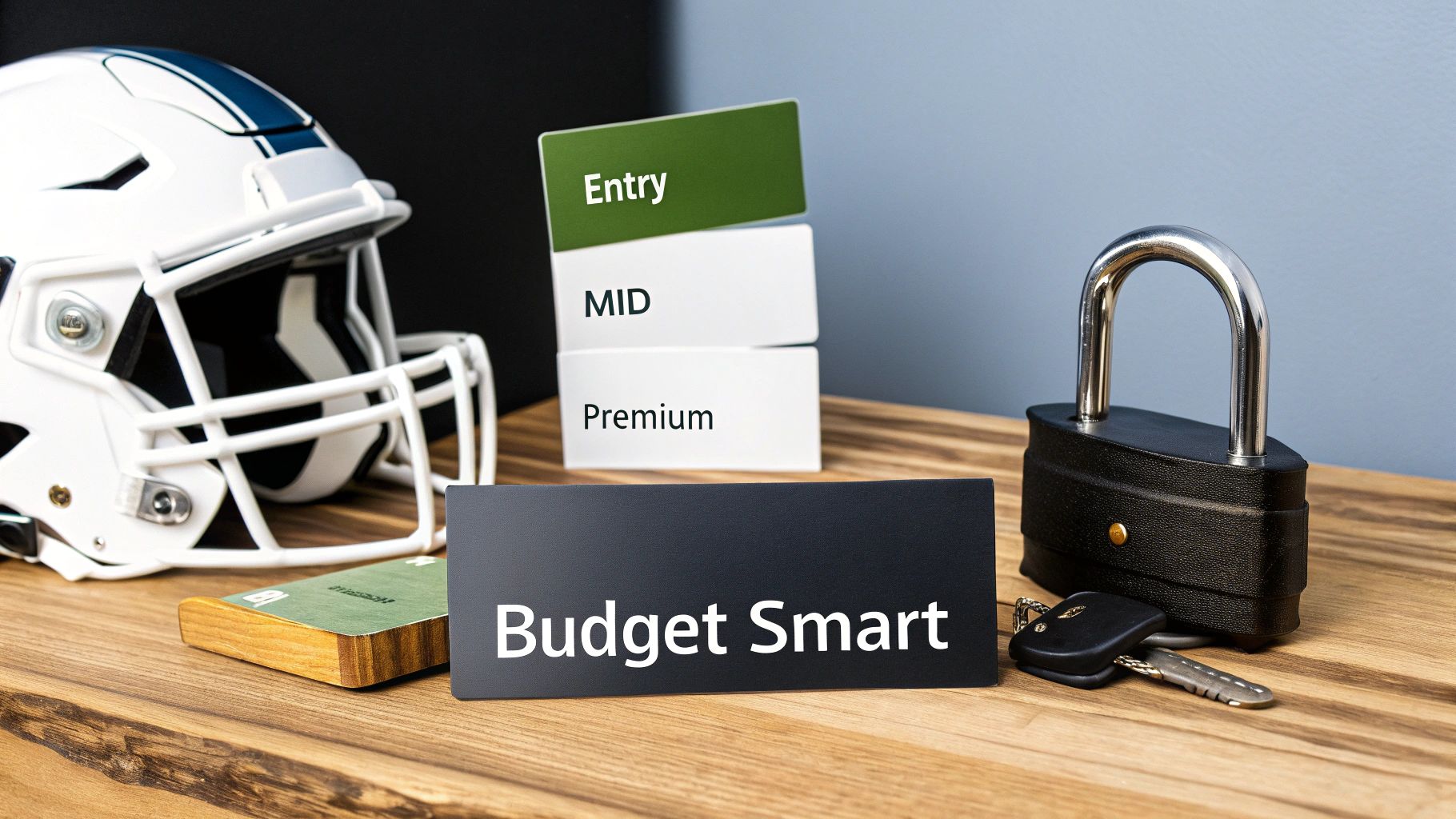
Even after you've crunched the numbers on range and speed, a few practical questions always pop up right before you pull the trigger. It’s these little details that often make the biggest difference in how much you’ll actually enjoy riding your scooter day in and day out.
Let's clear up some of the most common things people ask when they're trying to figure out how to choose an electric scooter. This is the stuff that separates a good scooter on paper from a great scooter in the real world.
Solid vs. Air-Filled Tyres: Which Is Better?
Ah, the great tyre debate. This really boils down to a classic trade-off: do you want maximum comfort or zero maintenance?
Air-filled (pneumatic) tyres are the undisputed king of comfort. They act like mini-suspension, easily soaking up all the cracks, bumps, and rough patches you'll find on most city streets. If your commute involves anything less than perfect pavement, you'll really appreciate the smoother ride. The only catch? Punctures can happen, though a good quality tyre sealant dramatically reduces the risk.
Then you have solid tyres. Their biggest selling point is that they are completely, 100% puncture-proof. That's a huge plus for peace of mind. The downside, however, is ride quality. You will feel every single vibration through the deck, which can get pretty uncomfortable on anything but the smoothest of surfaces.
For the vast majority of riders, our recommendation is to go with pneumatic tyres and add some anti-puncture sealant. You get that all-important comfortable ride with very little chance of getting a flat. It’s the best of both worlds.
What Does an IP Rating Mean, and Should I Care?
An IP rating (it stands for Ingress Protection) is a simple code that tells you how well your scooter is sealed against dust and water. You’ll see it written as two numbers, like IP54.
The first number is for solids (dust and grit), and the second is for liquids (rain). For anyone riding in places where a surprise downpour can happen, this is a non-negotiable feature.
- A rating like IP54 is pretty standard. It means the scooter is well-protected from dust and can handle splashes of water from any direction. Think of it as being "light rain ready."
- A higher rating, like IP67, means it’s completely sealed against dust and can even survive being temporarily dropped in water.
Bottom line: if you plan on riding year-round, don’t even consider a scooter that doesn't have an official IP rating.
How Much Maintenance Does an E-Scooter Actually Need?
Good news! Electric scooters are surprisingly low-maintenance. There’s no oil to change or engine to service. Your main responsibility is just a series of quick, simple checks to keep everything in top shape.
Every so often, you'll want to:
- Check your tyre pressure (if you have air-filled tyres).
- Give the brakes a squeeze to make sure they feel sharp.
- Check that the key bolts on the handlebars and wheels are snug.
The battery is the only component that wears down over time. It will slowly lose its total capacity after a few hundred charge cycles, which for most people takes about 2-4 years. To get the most life out of it, try to keep the charge between 20% and 80% when you can.
Eventually, you'll need to replace parts like brake pads or tyres, but that's just normal wear and tear based on how much you ride.
Ready to find the perfect ride that matches your needs and budget? The team at Punk Ride LLC has curated a fantastic selection of top-tier electric scooters from the best brands in the business. Explore our collection and start your urban adventure today at https://www.punkride.com.




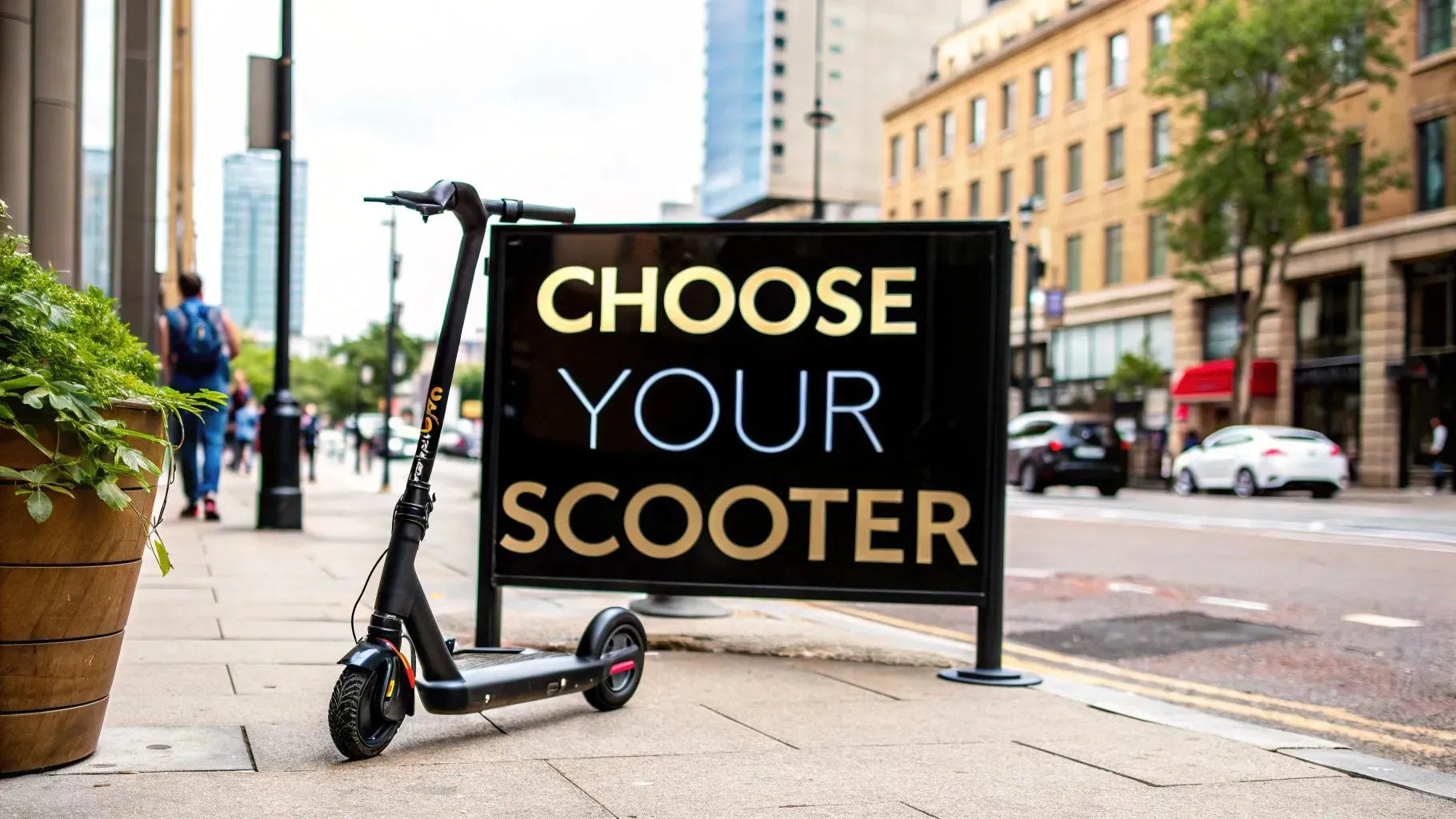
Share:
Decoding Electric Scooter Range
How to Choose an Ebike: A Clear Guide to Motors & Batteries